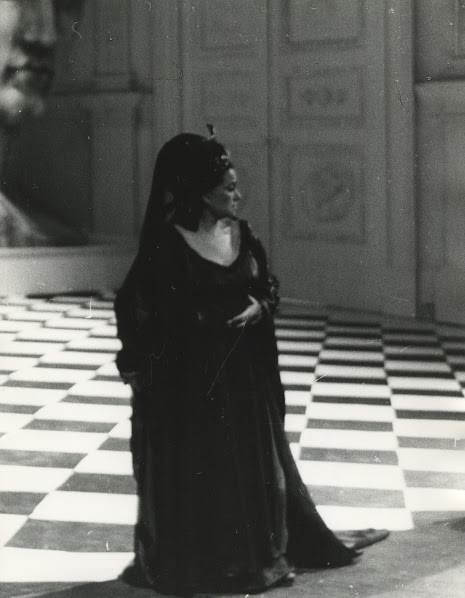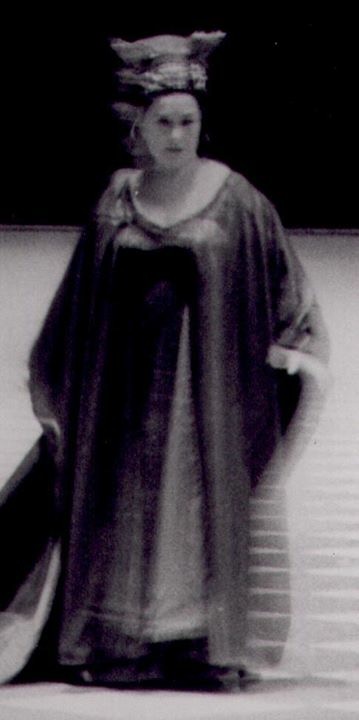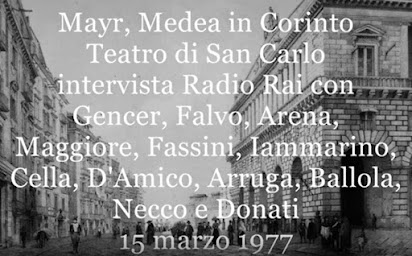MEDEA IN CORINTO
Johann Simon Mayr (1763 -1845)

Opera in two acts in Italian
Libretto: Felice RomaniPremièr at Teatro San Carlo, Naples – 28 November 1813
15†, 18, 20†, 23, 25, 27 March 1977
Teatro San Carlo, Napoli
Conductor: Maurizio Arena
Chorus master: Giacomo Maggiore
Stage director: Alberto Fassini
Scene and costumes: Pier Luigi Samaritani
Creonte King of Corinth GIANFRANCO CASARINI bass
Egeo King of Athens GIANFRANCO PASTINE tenorGiasone WILLIAM JOHNS tenor
Medea his wife LEYLA GENCER soprano [Role debut]
Creusa Creonte’s daughter CECILA FUSCO soprano
Evandro confident of Giasone LUIGI PAOLILLO tenor
Ismene confident of Medea IVANA CAVALLINI soprano
Tideo Giasone’s friend ERMANNO LORENZI tenor
Time: Antiquity
Place: Corinth
† Recording
date
* Note: Besides of 15 & 20 March 1977, opera also recorded on 13.03.1977 during the general rehearsal.
FONDAZIONE GIORGIO CINI
MEDEA IN CORINTO
BELISARIO
JERUSALEM / GERUSALEMME
LA VESTALE
LES MARTYRS
MEDEA
OPERA MAGAZINE
1977 February
OPERA MAGAZINE
1977 March
INTERVISTA / INTERVIEW RAI
1977.03.15
Teatro San Carlo, Napoli
Recording of the Interview
1977.03.15
Intervistatori:
Luigi Necco e Paolo Donati
Intervistati: Leyla
Gencer, Adriano Falvo, Maurizio Arena, Giacomo Maggiore, Alberto Fassini, Lina
Iammarino, Franca Cella, Fedel D'Amico, Lorenzo Arruga, Giovanni Carli Ballola
CORRIERE DELLA SERA
1977.03.17
OPERA MAGAZINE
1977 July
LA REPUBBLICA
2015.07.30
FIORELLA SASSANELLI
La Medea in Corinto per il Valle d'Itria
Dopo i confronti con le "altre" Medee, proposte
ai concerti, ecco finalmente "la" Medea del Valle d'Itria 2015. A
vent'anni esatti dalla Médée di Cherubini programmata a Martina Franca, stasera
Fabio Luisi, prestigioso direttore musicale di questa splendida realtà,
pugliese per nascita ma sempre più internazionale per attenzioni e strategie,
dirige Medea in Corinto (Napoli, Teatro San Carlo, 1813) di Giovanni Simone
Mayr (alle 21 al chiostro di Palazzo Ducale). Quando l'impresario del San Carlo
si rivolse a lui per un'opera, la direzione del teatro intendeva puntare su un
compositore che – per la formazione europea e un gusto vicino all'estetica
d'oltralpe – non avrebbe affatto deluso il governo napoleonico. Medea in
Corinto è infatti un lavoro anomalo rispetto alle opere italiane di quegli
anni: l'orchestra ha una scrittura molto fitta, sinceramente sinfonica, che
riserva bellissime sorprese nell'orchestrazione (molti gli assolo strumentali
nelle arie che quasi diventano duetti per voce e strumento). Anche i ruoli
vocali sono molto impegnativi, al punto che quello di Medea ha da solo
contributo alla fortuna di almeno tre grandi interpreti: Isabella Colbran
(futura moglie di Rossini), Giuditta Pasta e Leyla Gencer. Cast internazionale,
regia di Benedetto Sicca, scene di Maria Paola Di Francesco, costumi di Tommaso
Lagattolla.
OPERA NEWS
MEDEA IN CORINTO
Links from OPERA
NEWS ARCHIVES related with Gencer’s performances
...
There's a late-career Leyla Gencer scream-through from the San Carlo in 1977;
OperaRara (1993) offers the tamer Jane Eaglen, plus Yvonne Kenny and Bruce Ford. ...
COMPLETE RECORDING
1977.03.15
Recording Excerpts [1977.03.15]
Sommi dei, che i giuramenti Act I
Antica notte, Tartaro profondo ... Act II
O furie, che un giorno guideste ... Act II
FROM CD BOOKLET
MEDEA IN CORINTO
In the basilica of Santa Maria Maggiore in Bergamo, Johannes Simon Mayr and Donizetti are buried side by side. The Bavarian Mayr was Donizetti's teacher and there is a story that tells us how Mayr replied when he was told his pupil had appropriated some of his tunes: "Donizetti honours me too much." Giovanni Simone Mayr was born Johann Simon Mayr on June 14, 1763, near Ingolstadt, Bavaria the son of the organist Joseph Mayr who was his first music teacher. In 1787 he went to Italy to continue his musical studies. He first worked under Carlo Lenzi, maestro di cappella of the Bergamo Cathedral and in 1790 moved to Venice where he played viola in the orchestra of the Teatro della Fenice while studying under Ferdinando Bertoni. The latter not only gave Mayr a rigorous training in church music but introduced him to the Neapolitan operatic style and the late operas of Gluck. During the next thirty years Mayr composed nearly seventy operas, the most important of which were performed in the major theatres of Europe. Mayr remained in Bergamo until his death on December 2, 1845, honoured by all. In the front row of the vast assemblage of those who attended his funeral stood Giuseppe Verdi.
When Guiditta Pasta referred to "Medea - that grand fiendish role" it was Mayr's opera she was thinking of not the latterly more famous version by Cherubini. Enrico Tellini, writing in Opera, commented on the production as follows: "Leyla Gencer, adding a new role to her wide repertory, dominated the performance as Medea. Miss Gencer never ceases to surprise with her unexpected resources: on this occasion she displayed a smooth, controlled bel- canto style perfectly in line with the music itself and with the intentions of both conductor and producer. In spite of such refined singing, her clear diction and ability to change the colour of her tone according to the dramatic situation made her Medea impressive, alive and moving. William Johns supported her well as Jason, with thoughtful phrasing and well-handled pianissimi; Maurizio Arena's conducting was clean, light and elegant and made Mayr's score sound like Gluck or Spontini."
The librettist of Mayr's "Medea in Corinto" Felice Romani also provided texts of texts of Rossini's II Turco in Italia, Donizetti's L'Elisire d'Amore, Bellini's Norma and Verdi's Un Giorno di Regno. The opera opens with a tender scene between Creusa and her maidens who assure her that Medea can do her no harm. Jason has returned from the wars and the forthcoming marriage is discussed between Creusa, Jason and Creon. Medea enters but is told by the Corinthians to leave the city. Medea reproaches Jason for abandoning her. Aegeus has come from Athens to wed Creusa but finds the city closed to him. Ismene informs him of the forthcoming marriage between Creusa and Jason. Medea and Aegeus watch the ceremony, unperceived among the crowd. Just as the ceremony is about to be completed, Medea overturns the altar and appeals on last time to Jason. Aegeus calls his men and Medea and Aegeus attempt to abduct Creusa. Jason and Creon rush to her defence and the curtain falls.
Act II: Creusa expresses her gratitude for her rescue. The scene changes to an underground grotto, not far from the sea. Medea invokes the furies to assist her in preparing a poisoned robe for Creusa. The scene shifts again to Creusa's apartments. Jason clams her fears. Aegeus has been thrown in prison because of his complicity in the attempted abduction of Creusa. By her magic Medea is able to pass through the walls of the prison and she liberates Aegeus. In another room of the palace Jason looks forward to his union with Creusa. Suddenly shrieks are heard. Creusa has put on Medea's poisoned robe and has been burned to death. Jason tries to kill himself. The chorus stops him and urges him to avenge Creusa's death. Medea, accompanied by Ismene, prepares to flee with the children. She is torn between maternal affection and the desire to hurt Jason by destroying his children. Medea suddenly appears on a balcony, triumphant, bearing the dagger red with the blood of Jason's children. Medea leaves in her chariot, drawn by two dragons as Jason falls senseless to the ground.

























